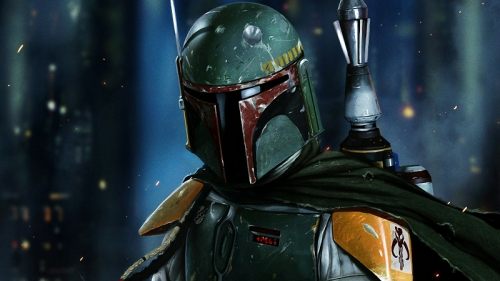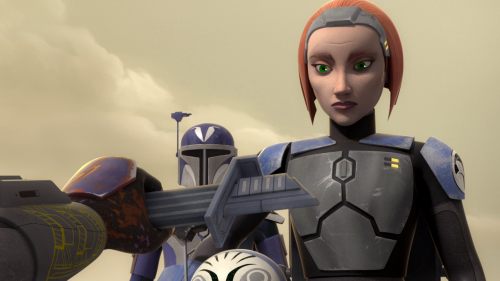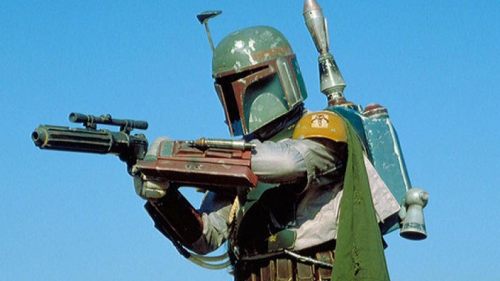STAR WARS: THE LAST JEDI Review: The STAR WARS Film That Finally Lives Up To EMPIRE STRIKES BACK
I will disappoint my son. He’s only six weeks old, but I know this for a fact, because Star Wars told me so. The Last Jedi, the magnificent middle chapter of the third (and presumably final) trilogy in the Skywalker Saga doesn’t have many good things to say about parents.
Beyond all the visual effects wizardry and convoluted mysticism, the most popular movie serial of all time is about how parents just don’t understand. Good luck finding a father figure worth a damn in a Galaxy Far, Far Away. They simply don’t exist. If they’re not murdering a bunch of younglings for sport, chances are they’ve abandoned you for the glamorous life of a smuggler. Changing diapers isn’t that bad, folks.
In a sense, Star Wars has always been a far-fetched allegory for the Baby Boomer generation—all fiery idealism and unwavering belief in the neat and tidy order of Western morality. Existence can be codified into two separate camps: good guys and bad guys, black shirts and white robes. Star Wars defined an era because it was about that era, down to its flirtation with Eastern mysticism and horrendous disco remixes. Luke Skywalker wasn’t that far removed from the Berkeley freshman getting a crash course in What’s Really Going On from his radical professors.
The genius of The Last Jedi (and its direct predecessor, The Force Awakens) is that it’s not shy about exploring the reckoning that’s befallen the Baby Boomers. Good and evil doesn’t seem quite so clear. Everyone’s hands are dirty in one way or another. Greed, lust for power, and self-interested cynicism won out. Whatever New Hope Star Wars represented in 1977 is in retreat. How can one make a cathartic action romp about space Nazis in a time when actual Nazis are reasserting themselves in the national political conversation? Simple: you make a movie about how hope dies.
Yes, The Last Jedi is a bleak film—a necessary comedown course correction after the giddiness of The Force Awakens. Without a doubt, this is the most depressing Star Wars movie yet. It’s content to be long and sad when it’s not thrilling. The losses for the heroes are more catastrophic than TheEmpire Strikes Back. The emotional stakes are higher than Rogue One, because we’re far more intimate with these characters and the story is not a fait accompli destined to end with a creepy CGI happy ending. Finn, Poe, Rey, Leia, and the rest of the Resistance lose. A lot. They keep on losing. The John Williams score doesn’t offer a ton of new themes, but it redeploys the existing ones in ever more downbeat ways. This is also the first Star Wars movie that takes real stylistic chances since the first film. There are cinematic devices and visuals employed by director Rian Johnson that we’ve never seen used in this series before. It manages to offer loads of surprises and subversions of cliché while still being recognizably Star Wars. In a broad sense, the plot of The Last Jedi is Empire Strikes Back in reverse, yet hardly derivative.
The core group of actors, a miracle of casting and chemistry, is asked to play much more than frenetic and funny. In particular, Oscar Isaac is given far more to do as Poe Dameron this time around, owing to the fact that in this film, his character didn’t have to be shoehorned into the final act after the filmmakers realized they didn’t want to kill him off. His purpose in the story remains the deconstruction of the traditional male sci-fi hero, but it doesn’t have to be so obvious in this film as it was in the last one.
John Boyega’s Finn trudges forward on what might be the most fascinating character arc in the entire new trilogy. He’s mostly off with Kelly Marie Tran’s new character, Rose, and Benicio Del Toro’s hacker, DJ. Add in Laura Dern as Vice Admiral Holdo and it’s clear that this trilogy isn’t the clean three-hander that the original was. One area where The Last Jedi struggles is keeping narrative momentum with all these characters and all of their separate plotlines. Empire really only had two parallel narratives: Vader’s pursuit of the Falcon and Luke’s training on Dagoba. There’s around four or five different threads to follow during The Last Jedi. How they all come together is slightly less elegant than Empire, but at least this whole ensemble gets to stay busy.
Well, maybe not Captain Phasma. At some point, someone needs to justify all the chatter and affection for this character, because she does nothing on screen to warrant it. Gwendoline Christie seems thrilled to do the press tours every couple years, even if she’s playing Boba Fett if he kept tripping on various banana peels in every movie. There has not been a more transparent, shallow attempt to sell toys in the Star Wars films since General Grievous, though Grievous had more screen time than Phasma.
Daisy Ridley continues to wow me with her work as Rey. Like Luke in Empire, her role is mostly passive—learning and asking questions of an inscrutable teacher. Where Rey differs is that it’s almost as though she’s more mature than Luke, more confident. Seeing Ridley play with our expectations of how her relationship with Luke will go is a pleasure.
As great as the new cast is, the heart and the soul of this film remains the original group. The late, great Carrie Fisher brings a grace and warmth to every scene she’s in. Her final few moments in the film pack a weight, even without factoring in her passing. Mark Hamill, finally given some lines to speak, trades the boyish charms of his first Star Wars run for a bug-eyed paranoia that belies a tremendous amount of guilt. Luke Skywalker, the titular New Hope himself, has given up. He sees the madness and the carnage of the world he thought he saved and throws up his hands in defeat. The enfant terrible named Kylo Ren is his fault. The kids are left to pick up the pieces yet again.
People my age, the dreaded “‘90s kids” who grew up with the worst Star Wars movies—the cursed prequels—look back at the promise of post-war America with a mixture of contempt and jealousy. You promised us a better tomorrow and we got terrorism, massive income inequality, the threat of nuclear war, political instability throughout the globe, and whatever devastation climate change will bring. Similarly, Luke, Leia, Han, and the Rebel Alliance promised a new Republic and a return to decency in the galaxy. That simply didn’t happen. Our new characters, particularly Rey and Kylo Ren, find themselves questioning the value of all that hope.
“Let the past die,” Rey is told by the former Ben Solo. Clear the deck. Start fresh. There’s something apocalyptic about this Star Wars movie. The First Order is obsessed with the past, recreating perceived glory days, rolling back progress, and making the galaxy great again (sound familiar?). Instead, the very structures of this universe are collapsing under their weight. A detour to the casino planet of Canto Bight shows us just who exactly profits from the perpetual instability of the worlds of Star Wars, a clear attempt at a message moment to connect the fantasy with our reality. No one is all good or all bad, even if the Original Trilogy sometimes made it seem that way. The tug of war between light and dark is equally good for business as it is destructive. What Kylo Ren wants to replace the black-and-white dichotomy that’s defined these movies with is not clear. It doesn’t seem to matter to him. He just wants change for change’s sake. Peering down into the sinkhole of modern life, who wouldn’t want to rip it up and start anew? When anger is your primary motivator, that can really start to sound very appealing. There are few things more painful to accept than when the people tasked with protecting you—your parents, your teachers, your bosses, your elected officials, your Jedi masters—fail to do so. These new Star Wars film resonate with today’s audiences, because they’re just as good at dramatizing the deep down, underneath of each of us.
The end-of-it-all moment The Last Jedi leaves moviegoers in offers very few clues for how JJ Abrams will wrap this story up. There’s no clear path forward, no “let’s save Han from Jabba” plot point to jump to. The final shot, maybe the most moving scene in a film full of moving scenes, implies that it’s entirely possible that Episode IX will jump many, many years into the future. What the end of The Last Jedi does do is leave us with a small taste of what is in such short supply in both Star Wars and the real world: hope, in the form of the next next generation. Yes, we will disappoint our children, but that’s because they see the way life is and how it can be better. The Star Wars generation might not have saved the world, but there’s always another New Hope out there just beyond the horizon.



